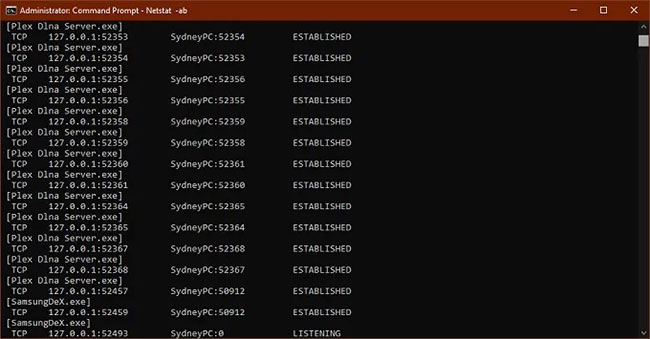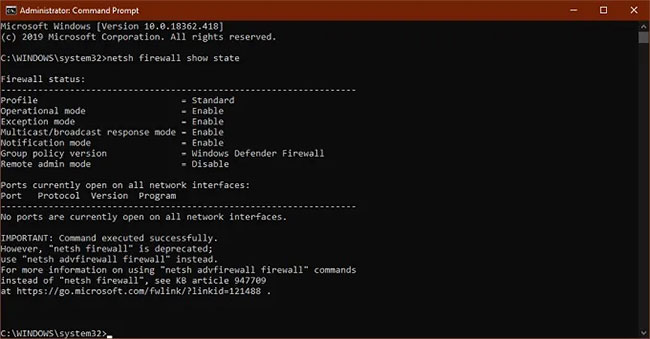How to find open and blocked TCP / UDP ports
Most likely you are reading this article because an application you are trying to run indicates a port is blocked or you have read the documentation that leaving certain ports open on the network could cause security issues.
In this article, TipsMake.com will explain what a TCP / UDP port is and how to check your computer for open or closed ports.
What is a TCP / UDP port?
The two common types of ports on modern networks are called TCP and UDP. These two types of ports use different network protocols.
Both types of ports are built on the basic Internet Protocol (IP), which makes the Internet and home network work well. However, they are suitable for different applications.
The big difference is that when you send information via UDP, the sender doesn't have to establish a connection with the recipient before starting the conversation. This is almost like sending a letter. You don't know if other people will receive your message and there is no guarantee that you will get any feedback.
On the other hand, TCP is more like making phone calls. The recipient must receive connection data and have a flow of information back and forth until someone deliberately hung up.
UDP messages are usually broadcast over the network to anyone listening on the designated UDP port. This makes it the perfect choice for network-related messages, streaming Voice over Internet Protocol (VoIP), video games and broadcasts.
These applications benefit from the low latency and unrelated information flow of UDP. TCP is much more common than UDP and completely ensures that all data received is error free.
Which ports are usually opened by default?
There are many ports. The port number can range from 0 to 65535 ! But that doesn't mean that any application can choose an arbitrary port, since there are standards and ranges set.
Ports 0 - 1023 are linked to some of the most basic and important network services. This makes sense, since the lower numbered ports are pre-assigned. For example, the SMTP protocol for email is used exclusively by port 25.
Ports 1024 - 49151 are called registered ports and are assigned to important common services, such as OpenVPN on port 1194 or Microsoft SQL on ports 1433 and 1434.
The rest of the port numbers are called dynamic or private ports. These ports are not reserved and anyone can use them online to support a specific service. The only problem arises when two or more services on the same network are using the same port.
While it is not possible to list all important ports, here are some common and very useful ports to know:
- 20 - FTP (File Transfer Protocol)
- 22 - Secure Shell (SSH)
- 25 - Simple Mail Transfer Protocol (SMTP)
- 53 - Domain Name System (DNS)
- 80 - Hypertext Transfer Protocol (HTTP)
- 110 - Post Office Protocol (POP3)
- 143 - Internet Message Access Protocol (IMAP)
- 443 - HTTP Secure (HTTPS)
Because there are thousands of common port numbers, the easiest approach is to memorize ranges. This will tell you whether a given port is reserved or not. Thanks to Google, you can also look up services that use a specific port without spending a lot of time.
Find open ports in Windows
 Open ports in Windows
Open ports in Windows Now you have all the basic knowledge of TCP and UDP ports. It's time to find out which ports are open and used on your computer.
Refer to the article: Check the port (port) is open, the connection is being made in the system for details.
Scan for blocked ports
The above section focuses on finding out which ports are being used by which applications, but does not tell us which ports are being blocked by Windows Firewall.
- Again, open the Command Prompt with admin rights.
- With the Command Prompt open, type:
netsh firewall show state The port is being blocked by Windows Firewall
The port is being blocked by Windows Firewall Currently, using the show state command is the quickest and easiest way to get portal information.
Windows Firewall does not block a port does not mean that the router or ISP. Therefore, it is necessary to check if any external blocking is happening.
- Open Command Prompt with admin rights.
- With the Command Prompt open, type:
netstat -ano | findstr -i SYN_SENT Check for external blocking
Check for external blocking If you do not see anything listed, it means that no ports have been blocked. If several ports are listed, that means they are being blocked. If a port not blocked by Windows is shown here, you may want to check your router or send an email to your ISP, if you can't switch to another port.
You should read it
- Instructions to scan the network port with Advanced Port Scanner
- How to change LPT port in CMOS
- How to connect printer 2.0 USB port to USB 3.0 port on Windows 10
- Summary of some simple ways to disable USB ports on Windows computers
- How to set up Port Forwarding on Draytek router
- What is DVI port? Classification of popular DVI ports today
- How to convert WAN port to LAN on router
- Decoding HDMI sign (STB) on TV
May be interested
- 5 easy ways to know if someone has blocked you on Discord
 are you worried that a friend has blocked you on discord? even though discord doesn't tell you directly, there are easy ways to tell if someone has blocked you on discord. you can even see if you've been blocked without sending a direct message! this tipsmake article covers all the signs that you're blocked on discord, whether you're using a computer or the mobile app.
are you worried that a friend has blocked you on discord? even though discord doesn't tell you directly, there are easy ways to tell if someone has blocked you on discord. you can even see if you've been blocked without sending a direct message! this tipsmake article covers all the signs that you're blocked on discord, whether you're using a computer or the mobile app. - How to Know if Your Number is Blocked
 finding out if you've been blocked by someone can be uncomfortable. if you think you've been blocked and need to check one way or another, you can call the number a few times and listen to how the call ends. note: if you know that the person has blocked you and still tries to call, they may sue you for harassment.
finding out if you've been blocked by someone can be uncomfortable. if you think you've been blocked and need to check one way or another, you can call the number a few times and listen to how the call ends. note: if you know that the person has blocked you and still tries to call, they may sue you for harassment. - How to call when blocked number on iPhone?
 it may be for some reason that you have been blocked by a person, maybe because of a fight with your lover, or it may be because you accidentally let your baby play. however, sometimes you have an urgent need to inform that person but you cannot call or text because it is blocked. the following article will show you how to call when blocking numbers on iphone.
it may be for some reason that you have been blocked by a person, maybe because of a fight with your lover, or it may be because you accidentally let your baby play. however, sometimes you have an urgent need to inform that person but you cannot call or text because it is blocked. the following article will show you how to call when blocking numbers on iphone. - Summary of several ways to access blocked websites
 to access the blocked website you can use some solutions such as change dns, edit host file, change ip address (vpn, socks, ssh), ... below is a guide to access blocked website details.
to access the blocked website you can use some solutions such as change dns, edit host file, change ip address (vpn, socks, ssh), ... below is a guide to access blocked website details. - How to use the connection ports of HDTV
 in addition to using the connection ports like regular tvs, hdtvs also have connection ports for hd video and audio signals.
in addition to using the connection ports like regular tvs, hdtvs also have connection ports for hd video and audio signals. - 9 Most Important Ports Your Smart TV Should Have
 whether you're buying a new smart tv or just want to get the most out of the one you have in your living room, knowing which ports really matter (and why) can save you a lot of trouble down the road.
whether you're buying a new smart tv or just want to get the most out of the one you have in your living room, knowing which ports really matter (and why) can save you a lot of trouble down the road. - Open Word file when blocked, locked or error
 we are familiar with office 2007, 2010 their interface is easy to manipulate and use. at interface 2013, 2016, some features are smarter but hidden. so when some of the corrupted files need reinstallation, it is difficult to find.
we are familiar with office 2007, 2010 their interface is easy to manipulate and use. at interface 2013, 2016, some features are smarter but hidden. so when some of the corrupted files need reinstallation, it is difficult to find. - How to download games, applications blocked in Vietnam on Android phones
 currently there are a number of blocked games and applications in vietnam that cannot be downloaded and installed. this is due to geographic and country differences, so you need to find other ways to be able to download blocked games and applications in vietnam. tipsmake will guide you through this method.
currently there are a number of blocked games and applications in vietnam that cannot be downloaded and installed. this is due to geographic and country differences, so you need to find other ways to be able to download blocked games and applications in vietnam. tipsmake will guide you through this method. - How to open a port with Windows Firewall in Windows 10
 if an application or program requires a specific port to be opened, here's how you can use windows firewall to open a port in windows 10.
if an application or program requires a specific port to be opened, here's how you can use windows firewall to open a port in windows 10. - How to list all physical Ethernet ports on Linux server
 unlike conventional servers, rack servers must be resilient and often contain several physical ethernet ports or nics (network interface cards) to be able to connect to multiple networks at the same time.
unlike conventional servers, rack servers must be resilient and often contain several physical ethernet ports or nics (network interface cards) to be able to connect to multiple networks at the same time.










 Set up Windows Server 2016 with a static IP address
Set up Windows Server 2016 with a static IP address The security of the webcam is extremely simple
The security of the webcam is extremely simple Kaspersky Security Cloud guide to install Kaspersky Security Cloud for free
Kaspersky Security Cloud guide to install Kaspersky Security Cloud for free Can your iPhone be hacked or not?
Can your iPhone be hacked or not? Detect 2 serious security holes in the Zoom application
Detect 2 serious security holes in the Zoom application